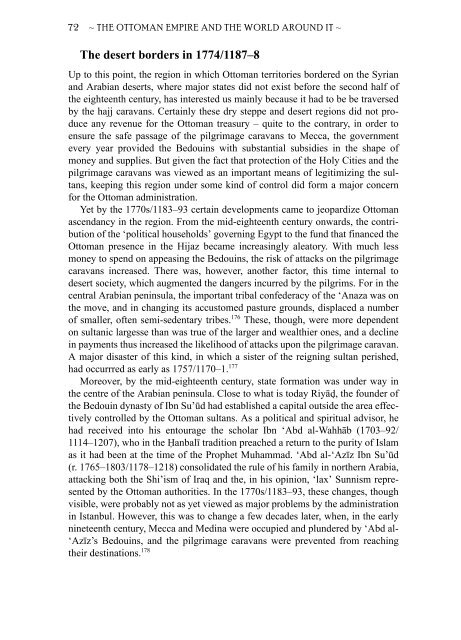The Ottoman Empire and the World Around It - Course Information
The Ottoman Empire and the World Around It - Course Information
The Ottoman Empire and the World Around It - Course Information
Create successful ePaper yourself
Turn your PDF publications into a flip-book with our unique Google optimized e-Paper software.
72 ~ THE OTTOMAN EMPIRE AND THE WORLD AROUND IT ~<br />
<strong>The</strong> desert borders in 1774/1187–8<br />
Up to this point, <strong>the</strong> region in which <strong>Ottoman</strong> territories bordered on <strong>the</strong> Syrian<br />
<strong>and</strong> Arabian deserts, where major states did not exist before <strong>the</strong> second half of<br />
<strong>the</strong> eighteenth century, has interested us mainly because it had to be be traversed<br />
by <strong>the</strong> hajj caravans. Certainly <strong>the</strong>se dry steppe <strong>and</strong> desert regions did not produce<br />
any revenue for <strong>the</strong> <strong>Ottoman</strong> treasury – quite to <strong>the</strong> contrary, in order to<br />
ensure <strong>the</strong> safe passage of <strong>the</strong> pilgrimage caravans to Mecca, <strong>the</strong> government<br />
every year provided <strong>the</strong> Bedouins with substantial subsidies in <strong>the</strong> shape of<br />
money <strong>and</strong> supplies. But given <strong>the</strong> fact that protection of <strong>the</strong> Holy Cities <strong>and</strong> <strong>the</strong><br />
pilgrimage caravans was viewed as an important means of legitimizing <strong>the</strong> sultans,<br />
keeping this region under some kind of control did form a major concern<br />
for <strong>the</strong> <strong>Ottoman</strong> administration.<br />
Yet by <strong>the</strong> 1770s/1183–93 certain developments came to jeopardize <strong>Ottoman</strong><br />
ascendancy in <strong>the</strong> region. From <strong>the</strong> mid-eighteenth century onwards, <strong>the</strong> contribution<br />
of <strong>the</strong> ‘political households’ governing Egypt to <strong>the</strong> fund that financed <strong>the</strong><br />
<strong>Ottoman</strong> presence in <strong>the</strong> Hijaz became increasingly aleatory. With much less<br />
money to spend on appeasing <strong>the</strong> Bedouins, <strong>the</strong> risk of attacks on <strong>the</strong> pilgrimage<br />
caravans increased. <strong>The</strong>re was, however, ano<strong>the</strong>r factor, this time internal to<br />
desert society, which augmented <strong>the</strong> dangers incurred by <strong>the</strong> pilgrims. For in <strong>the</strong><br />
central Arabian peninsula, <strong>the</strong> important tribal confederacy of <strong>the</strong> ‘Anaza was on<br />
<strong>the</strong> move, <strong>and</strong> in changing its accustomed pasture grounds, displaced a number<br />
of smaller, often semi-sedentary tribes. 176 <strong>The</strong>se, though, were more dependent<br />
on sultanic largesse than was true of <strong>the</strong> larger <strong>and</strong> wealthier ones, <strong>and</strong> a decline<br />
in payments thus increased <strong>the</strong> likelihood of attacks upon <strong>the</strong> pilgrimage caravan.<br />
A major disaster of this kind, in which a sister of <strong>the</strong> reigning sultan perished,<br />
had occurrred as early as 1757/1170–1. 177<br />
Moreover, by <strong>the</strong> mid-eighteenth century, state formation was under way in<br />
<strong>the</strong> centre of <strong>the</strong> Arabian peninsula. Close to what is today Riyā , <strong>the</strong> founder of<br />
<strong>the</strong> Bedouin dynasty of Ibn Su’ūd had established a capital outside <strong>the</strong> area effectively<br />
controlled by <strong>the</strong> <strong>Ottoman</strong> sultans. As a political <strong>and</strong> spiritual advisor, he<br />
had received into his entourage <strong>the</strong> scholar Ibn ‘Abd al-Wahhāb (1703–92/<br />
1114–1207), who in <strong>the</strong> anbalī tradition preached a return to <strong>the</strong> purity of Islam<br />
as it had been at <strong>the</strong> time of <strong>the</strong> Prophet Muhammad. ‘Abd al-‘Azīz Ibn Su’ūd<br />
(r. 1765–1803/1178–1218) consolidated <strong>the</strong> rule of his family in nor<strong>the</strong>rn Arabia,<br />
attacking both <strong>the</strong> Shi’ism of Iraq <strong>and</strong> <strong>the</strong>, in his opinion, ‘lax’ Sunnism represented<br />
by <strong>the</strong> <strong>Ottoman</strong> authorities. In <strong>the</strong> 1770s/1183–93, <strong>the</strong>se changes, though<br />
visible, were probably not as yet viewed as major problems by <strong>the</strong> administration<br />
in Istanbul. However, this was to change a few decades later, when, in <strong>the</strong> early<br />
nineteenth century, Mecca <strong>and</strong> Medina were occupied <strong>and</strong> plundered by ‘Abd al-<br />
‘Azīz’s Bedouins, <strong>and</strong> <strong>the</strong> pilgrimage caravans were prevented from reaching<br />
<strong>the</strong>ir destinations. 178<br />
d.<br />
H.


